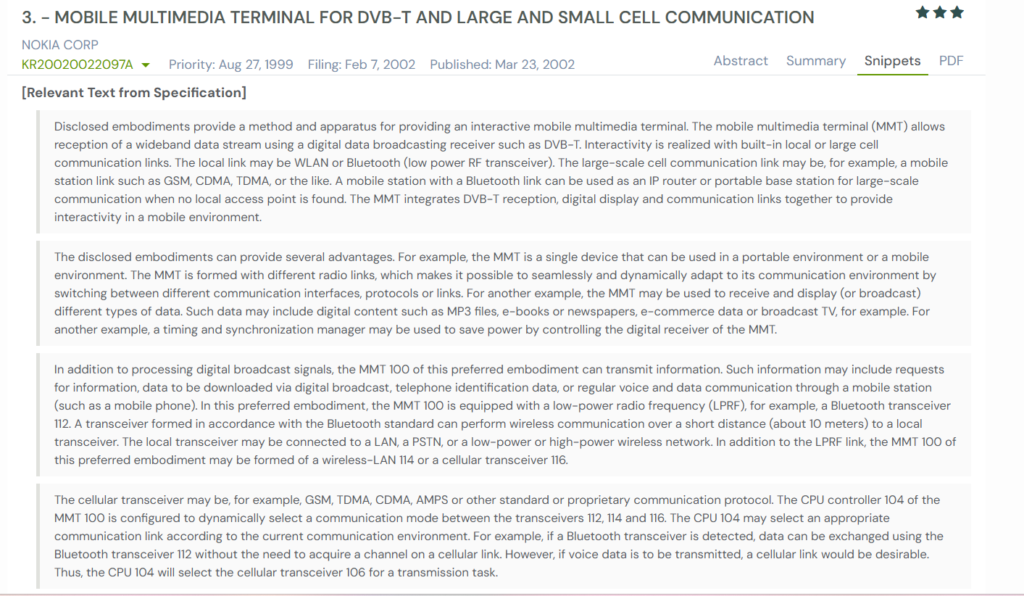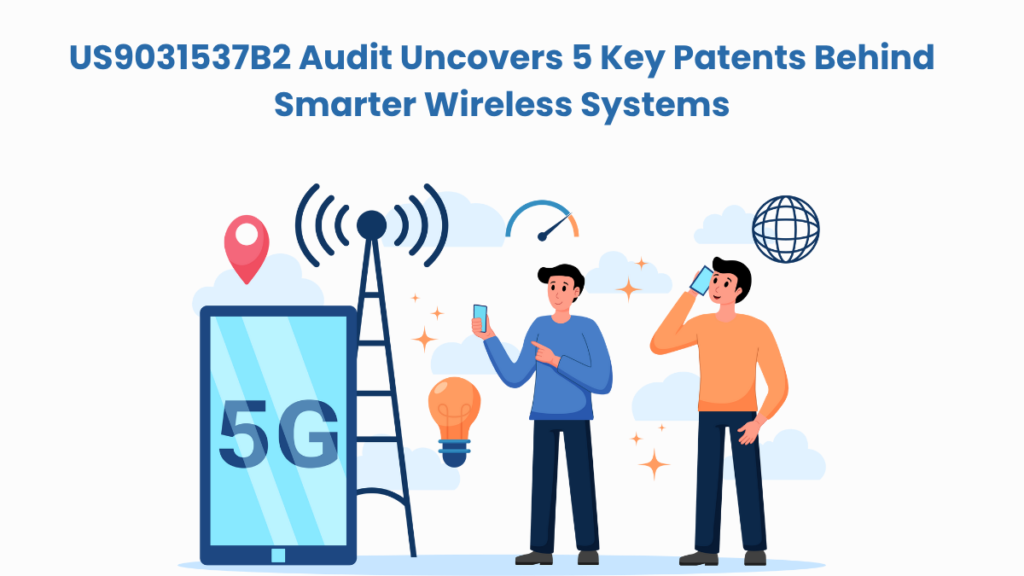Ever notice how your phone switches from Wi-Fi to mobile data without you even thinking about it? The call stays clear, the video keeps playing, and nothing skips a beat. That seamless experience started years ago with ideas like Patent US9031537B2.
This patent described a handheld device that could connect to any network, play media, and handle payments long before smartphones became what they are today.
Part of an extensive infringment campaign, this patent made us wonder: Was this invention truly new or just part of a bigger story already unfolding?
To find out, we used Global Patent Search tool to trace patents that helped shape this evolution. Together, they show how wireless communication slowly turned into the effortless experience we now take for granted.
Understanding What US9031537B2 Is All About
Patent US9031537B2 was an early vision of what we now call the smartphone. It described a handheld device that could connect through cellular, Wi-Fi, Bluetooth, and even older systems like infrared or RFID.
It could stream videos, display maps, process payments, and protect user data – all from one device. The real breakthrough was automation. The system could switch networks and manage data on its own, making the experience effortless for the user.
In hindsight, it wasn’t just about hardware. It was about foresight; imagining a device smart enough to handle everything for you.
Here are the key Features of US9031537B2
- Works across multiple networks: Connects through cellular, Wi-Fi, Bluetooth, infrared, and RFID. The device switches automatically to keep communication smooth.
- Handles multimedia with ease: A touchscreen displays video, text, and GPS navigation. Everything feels responsive and user-friendly.
- Built-in security and payments: Protects user data and supports mobile payments through phone bills or credit cards.
- GPS and external access: Uses GPS for navigation and can read data from external sources when needed.
In essence, US9031537B2 combined communication, media, and security into one intelligent system that worked quietly in the background.
That smooth experience on the surface also depends on what happens deeper inside the network. The US9584633B2 audit looks at exactly that side, how smarter routing and data handling keep connections stable when millions of devices talk at once.
Mapping Earlier Innovations Through US9031537B2
Before the idea of a smartphone became reality, several inventions were already trying to bring seamless communication and multimedia together.
By tracing related patents through the Global Patent Search tool, we can see how those early efforts built the foundation for today’s connected devices.
Each one pushed the boundary in its own way, improving how networks interact, how data travels, and how devices make complex communication feel simple.
1. GB2343597A- Early Steps Toward Seamless Connectivity
Filed on July 24, 1996, GB2343597A outlined a portable multimedia device that could send and receive both video and data across different wireless networks. Long before smart devices became common, it tried to make switching between cellular and Wi-Fi networks feel natural.
The patent described two-way multimedia access and a basic registration process before a user could connect. It didn’t include a touchscreen or interactive controls, but it captured the idea of flexible, network-agnostic communication.
Both patents share the same ambition: creating a device that moves effortlessly between network types while handling multimedia content. GB2343597A laid the groundwork for what later became everyday smartphone behavior: switching connections without breaking a call or stream.
Broader Story
The patent might look simple now, but in 1996 it was forward-thinking. It showed that seamless connectivity was already being imagined years before the modern smartphone era, making it an important link in the evolution that US9031537B2 built upon.
Recommended Read: US6813742B2 and 5 similar patents that improve wireless signal processing
2. WO9941909A1- The Step Toward Truly Connected Devices
WO9941909A1, filed on February 10, 1999, introduced a portable multimedia system that could exchange data over cellular networks using GSM and DECT standards. It featured a modular design where the control device and communication unit worked as detachable parts, a glimpse into how flexible mobile hardware could become.
One of its key strengths was security. The system used smart cards for encrypted communication and user authentication, ensuring that access stayed protected. While it didn’t include Wi-Fi or Bluetooth, it took a major step toward secure, mobile multimedia transmission.
You see both patents revolve around reliable, two-way data exchange over cellular networks. They also share a focus on protecting user access and data integrity. The difference is that US9031537B2 unified everything i.e. adding Wi-Fi, touch displays, and mobile payments.
Broader story
WO9941909A1 showed that mobile devices could go beyond basic calls and texts. By combining security and multimedia communication, it bridged the gap between hardware-driven systems and the integrated smart devices that US9031537B2 later envisioned.
3. KR100591369B1- The Step Toward Truly Connected Devices
The South Korean patent, filed in 2000, described a mobile terminal that could handle voice, video, and data at the same time. It supported many kinds of wireless networks such as GSM, CDMA, WLAN, and Bluetooth. This meant users could stay connected almost anywhere.
The device was made for multimedia. It could play videos, show maps, and support real-time conversations. A bright display and fast data transfer made it feel close to what we now think of as a smartphone.
Ultimately, both patents tried to make one device do everything. They focused on switching between networks, managing multimedia, and keeping things simple for the user. US9031537B2 built on the same ideas by adding mobile payments, stronger security, and more automation in the background.
Broader story
KR100591369B1 showed that inventors were already imagining all-in-one devices before the smartphone era began. It was a major step toward creating intelligent systems that could think, connect, and adapt without user effort.
Recommended Read: For a deeper look into automatic wireless provisioning, check out our breakdown of US8639935B2, the patent behind seamless device activation.
4. US20070083596A1- The Collaboration System That Brought Touch to Workspaces
US20070083596A1, published on April 12, 2007, described a multimedia collaboration setup that allowed people in different locations to share screens, text, and video in real time. Each station worked like a smart hub where users could view, store, and exchange information instantly.
The standout feature was its touchscreen interface. It had soft buttons that made navigation easier and allowed users to interact directly with what they saw on the screen. Although it mainly worked on local and wide area networks, not on mobile systems, it still laid the groundwork for interactive communication.
Both patents strived to make multimedia communication simple and interactive. They enabled people to exchange video and text while using touch-based controls. The key difference is that US20070083596A1 was designed for desktop or office environments, while US9031537B2 turned that same idea into something portable and wireless.
Broader story
The patent proved that touchscreens could redefine how people communicate and collaborate. It showed that interaction could be more natural when technology responded to touch, a concept that became central to later mobile devices like the one described in US9031537B2.
5. US5325423 – Early Attempts at Two-Way Multimedia
Published in 1994, US5325423 explored the idea of sending and receiving multimedia content through existing telephone and broadcast networks. It described a system that allowed users to exchange video, text, and images in both directions, much like an early version of modern communication platforms.
The setup used displays for viewing multimedia but did not include touch controls or wireless connectivity. Still, it introduced the idea of interactive media exchange long before smartphones and broadband became common.
Both patents share the goal of improving how users communicate and interact with multimedia content. US5325423 worked through wired networks, while US9031537B2 took the next step by bringing that same idea to mobile, wireless environments.
Broader story
Even though the technology behind US5325423 feels outdated today, it set the foundation for interactive communication. It showed that two-way exchange of media was possible, and that concept helped shape the innovations found in later wireless systems like US9031537B2.
Comparison Overview: How US9031537B2 Connects with 5 Related Wireless Communication Patents
Each of these patents helped shape how mobile devices handle connections, media, and data exchange.
Some built the foundation for multi-network communication. Others refined multimedia handling or touch-based interfaces.
Together, they show how the vision behind US9031537B2 became the blueprint for the smartphones we use today.
| Patent | Core Focus | Technical Overlap with US9031537B2 | The Broader Picture |
| GB2343597A (1996) | Designed a portable multimedia device that could send and receive data over both cellular and Wi-Fi networks. | Both patents explore switching between different network types to keep communication seamless. | One of the first steps toward devices that automatically move between Wi-Fi and mobile networks, a capability central to US9031537B2. |
| WO9941909A1 (1999) | Proposed a multimedia system with modular components and secure data access through smart cards. | Shares focus on cellular multimedia communication and secure access for data transfer. | Highlighted early ideas around secure mobile communication, paving the way for systems like those in US9031537B2. |
| KR100591369B1 (2000) | Described a mobile terminal that worked across multiple wireless technologies, including GSM, WLAN, and Bluetooth. | Closely mirrors US9031537B2 in supporting several network standards and real-time multimedia functions. | A clear step toward unified connectivity, making it one of the closest conceptual matches to US9031537B2. |
| US20070083596A1 (2007) | Focused on collaborative multimedia systems with touch-sensitive interfaces for data sharing and communication. | Aligns on touch-based controls and multimedia interaction, though limited to LAN/WAN environments. | Demonstrated how touchscreens could transform user communication, influencing later handheld and mobile designs. |
| US5325423 (1994) | Explored early two-way multimedia communication through wired telephone and broadcast systems. | Shares the concept of exchanging video and text data interactively, though without wireless or mobile use. |
Together, these patents trace how phones grew from basic communicators into smart, connected systems.
Each one added a small breakthrough that made the next possible, and US9031537B2 brought those ideas together into a single, seamless design.
Such wireless breakthroughs often move from labs to products through technology transfer between innovators and manufacturers.
How to Use Global Patent Search to Uncover Similar Innovations?
When a patent like US9031537B2 lands in a courtroom, context becomes everything. Knowing what came before and what came after helps you see whether it broke new ground or just followed a path others had already started paving.
That’s where the Global Patent Search (GPS) tool proves its worth. It doesn’t just list similar patents, it maps the full ecosystem around them, showing how different ideas, features, and systems connect.
Here’s how you can use it effectively:
1. Start with a patent or idea: You can enter a patent number like US9031537B2 or try phrases such as multi-network switching or smart wireless communication. GPS understands both, surfacing related patents that share the same technical logic.

2. Skip the clutter, go straight to insight: Instead of forcing you through dense claim text, GPS highlights short, relevant snippets from matching patents. You get to see exactly where the overlap happens, and decide which ones deserve a deeper look.
3. Turn search into strategy: Whether you’re studying prior art, assessing litigation risk, or researching future R&D directions, GPS helps you trace the story behind the innovation.
It’s not just about finding similar patents. It’s about understanding how technology evolved and where the next big leap might come from.
In complex areas like wireless integration and mobile networks, seeing the bigger picture matters. Explore the tool and find how easily those connections come together!
Disclaimer: The information provided in this article is for informational purposes only and should not be considered legal advice. The related patent references mentioned are preliminary results from the Global Patent Search tool and do not guarantee legal significance. For a comprehensive related patent analysis, we recommend conducting a detailed search using GPS or consulting a patent attorney.




